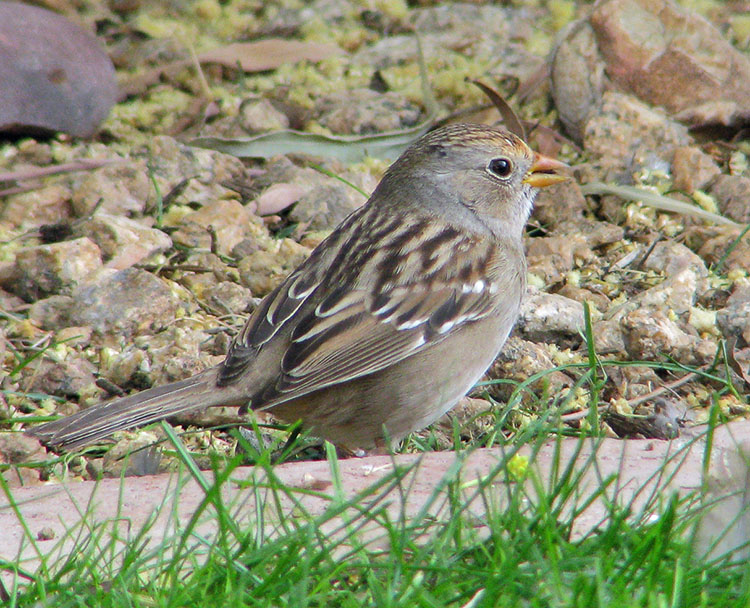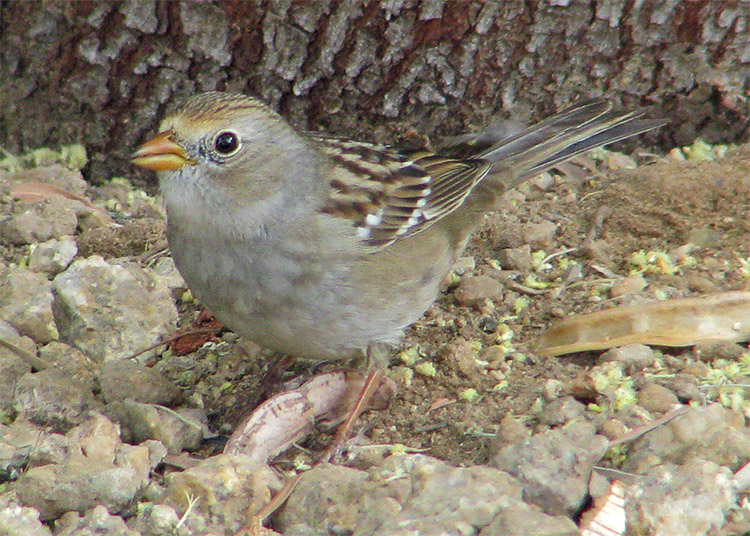 |
 |
|||||||||||||||||||||
|
||||||||||||||||||||||
Aberrant (?) White-crowned Sparrow (Zonotrichia leucophrys gambelii), Phoenix, residential area, Maricopa County
This apparent immature (hatch-year) White-crowned Sparrow in aberrant plumage was discovered by Pierre Deviche in a residential area in Phoenix on 28 November 2009. It was photographed on 30 November. The bird was trapped on 7 December under Pierre's Master Banding Permit from the Bird Banding Laboratory (USGS) for further photography and in-hand morphometric measurements, and was then immediately released on site. It was observed feeding in the same area where caught later that day and at least the next day.
In the field, the sparrow stood out from conspecific birds due to the lack of a dark eyeline and by the lack of brown and tan crown stripes. The latter were replaced with fine longitudinal brown streaks. In the field and in the hand, the bird showed a small amount of white at the base of the first four primaries, which is normally not the case in this species. Furthermore, uppertail coverts were paler than normal (see tail pictures) and tail feathers were clearly of two tones, with the proximal half lighter brown than the distal half. This pattern is not normally observed in White-crowned Sparrows either. The remainder of the plumage, including the back color and pattern, and the bill color appeared rather typical of immature Gambel's White-crowned Sparrow, the subspecies that normally winters in Arizona.
The abnormal tail color pattern suggests a deficient deposition of pigments into tail feathers when they were growing, i.e., within weeks of hatching. This type of deficiency in birds often results from nutritional or other stress. The abnormally pale color of the uppertail coverts and the crown also suggests pigment deposition deficiency as the bird was molting from juvenal to basic I (first winter) plumage. It is, however, possible that the sparrow underwent incomplete replacement of some feathers (in particular those of the crown) during prebasic I molt, thus resulting in the retention of some juvenal feathers. Measurements in the hand were typical of the species (body mass: 23.8 g), with the wing chord (71 mm) indicating that it is a female.
Hybridization between White-crowned and other sparrow species, including
Golden-crowned Sparrow, has been documented. The head pattern of this bird does
superficially resemble both immature Golden-crowned and, to a lesser extent,
immature Harris's Sparrow. However, the above plumage features are consistent
with the view that the Phoenix bird is an aberrant and paler-than-normal
White-crowned Sparrow rather than a hybrid between this and another species. We
are not aware of White-crowned Sparrows with similar plumage being previously
observed in Arizona or other states.


30 November 2009, Photos by Pierre Deviche


2-7 December 2009, photos by Pierre Deviche
All photos are copyrighted© by photographerSubmitted on 08 December 2009
|
©2005
|
HOME | | | REPORT SIGHTINGS | | | PHOTOS | | | BIRDING | | | JOURNAL | | | ABOUT US | | | CHECKLISTS | | | AZ BIRD COMMITTEE | | | EVENTS | | | LINKS |